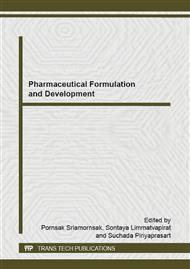p.95
p.99
p.103
p.107
p.111
p.115
p.119
p.124
p.128
In Vitro Antioxidant Activity of Electrospun Chitosan Aqueous Salts Based Nanofiber Mats
Abstract:
The aim of this study was to investigate the antioxidant activities of chitosan acetate (CS-acetate), chitosan hydroxybenzotriazole (CS-HOBt), chitosan thiamine pyrophosphate (CS-TPP) and chitosan ethylenediaminetetraacetic acid (CS-EDTA) nanofiber mats. Chitosan was dissolved with hydroxybenzotriazole (HOBt), thiamine pyrophosphate (TPP) and ethylenediaminetetraacetic acid (EDTA) in distilled water. These chitosan aqueous salts were blended with polyvinyl alcohol (PVA) at volume ratio 30/70 chitosan salts/PVA and prepared to nanofibers via electrospinning process. The morphology of electrospun chitosan aqueous salts based nanofiber mats were observed under scanning electron microscope (SEM). The antioxidant activities were determined employing various established in vitro system such as superoxide, hydroxyl radicals scavenging and metal ion chelating compared with pure PVA nanofiber mats. The results exhibited that the electrospun chitosan aqueous salts based nanofiber mats showed the different antioxidant activity depended on salt forms. Among the salt forms, CS-acetate nanofiber mats showed the highest superoxide radical scavenging effect while CS-HOBt nanofiber mats (IC50 = 7.53 mg/mL) showed the highest hydroxyl radical scavenging effect. For the metal ion chelating activity, CS-EDTA nanofiber mats showed the highest chelating activity (IC50 = 1.07 mg/mL). In summary, the antioxidant chitosan aqueous salt based nanofiber mats have potential for use in pharmaceutical applications.
Info:
Periodical:
Pages:
111-114
Citation:
Online since:
December 2014
Keywords:
Price:
Сopyright:
© 2015 Trans Tech Publications Ltd. All Rights Reserved
Share:
Citation:


